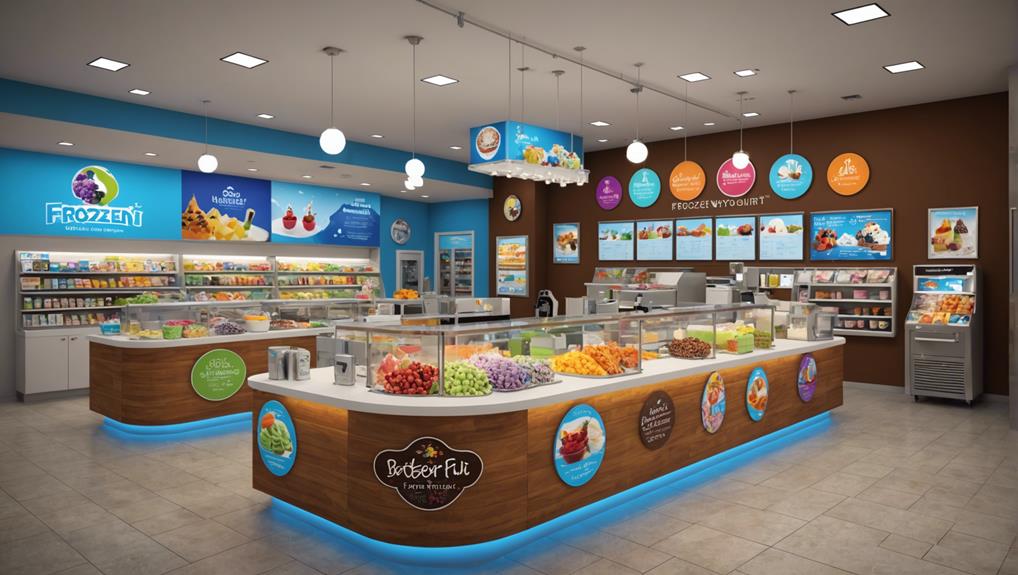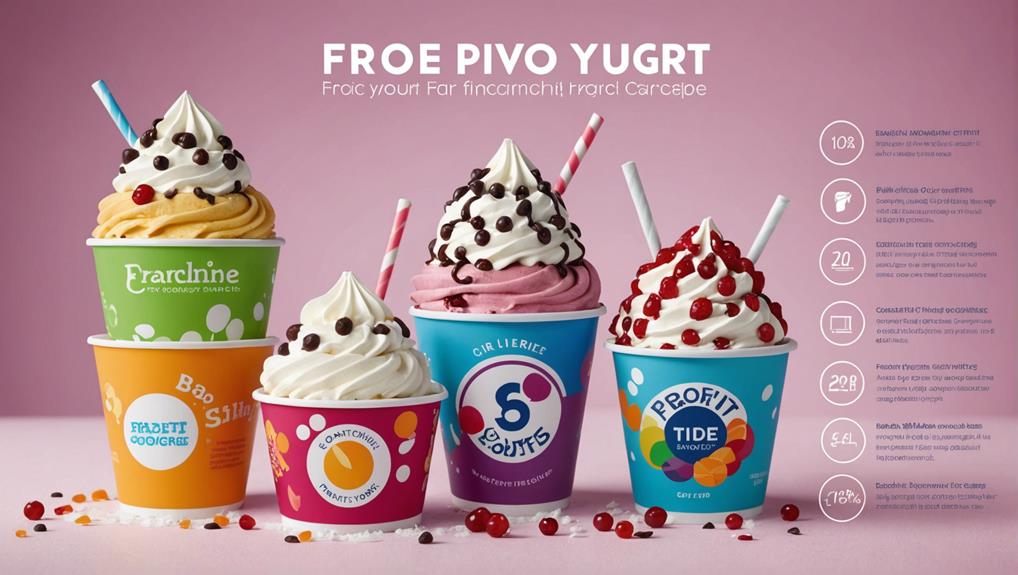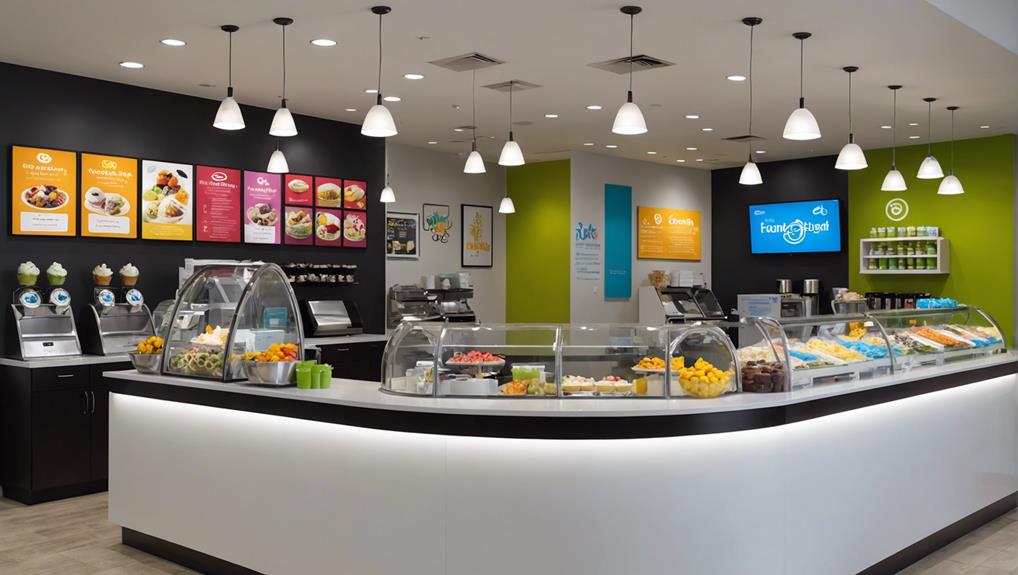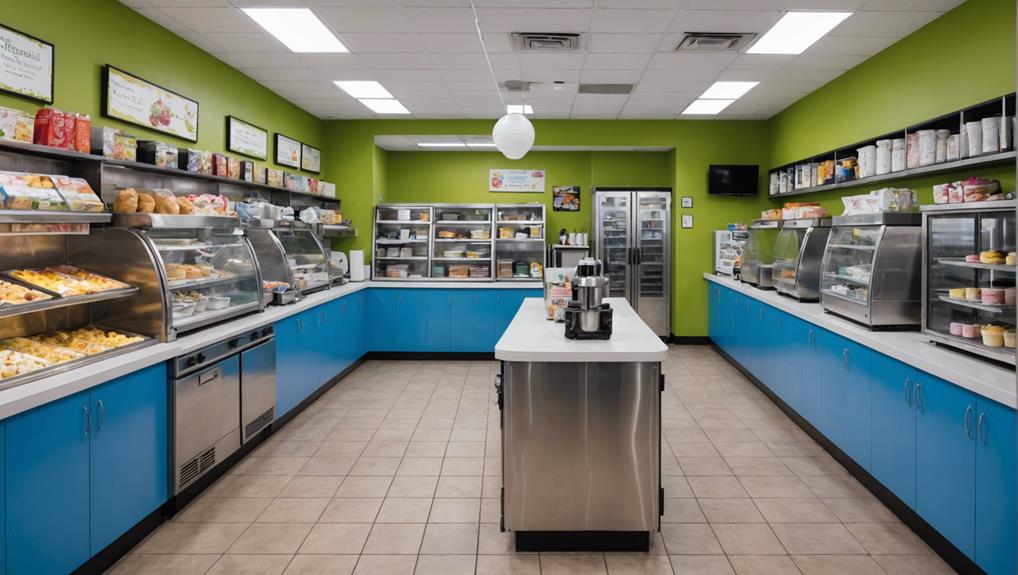Comparing frozen yogurt franchises like Menchies, Yogurtland, and Red Mango highlights variations in market share, investment costs, and ongoing support. Menchies holds a 19.1% market share with initial investments from $21,832 to $38,515, whereas Yogurtland’s investments range from $298,700 to $693,300. Red Mango’s investment ranges between $193,500 to $466,000. Franchise fees and royalty rates are similarly diverse, reflecting different business models and support structures. Operational consistency, marketing support, and ongoing training are essential for franchisee success. If you’re evaluating franchise opportunities, these differences are key indicators of long-term profitability. Continue to discover the nuances affecting franchise choice.
Key Takeaways
- Menchies has the lowest initial investment cost, ranging from $21,832 to $38,515.
- Yogurtland requires a higher initial investment, between $298,700 and $693,300.
- Red Mango’s investment range is $193,500 to $466,000, with a $30,000 franchise fee.
- Sweet Frog avoids oversaturated markets for better profitability and sustainability.
- All franchises charge a 6% royalty fee on gross sales.
Market Overview

Driven by fierce competition and evolving customer preferences, the frozen yogurt franchise market features top brands such as Menchies, Yogurtland, and Red Mango, with initial investments ranging from $21,832 to $693,300. The frozen yogurt industry has experienced a slight annual contraction of 0.4% from 2018 to 2023, primarily due to market saturation. Despite this, franchise businesses in this sector remain viable by focusing on strategic initiatives.
The frozen yogurt industry is characterized by its emphasis on health-conscious dessert options, aligning with broader consumer trends. Franchise businesses have responded by diversifying their product offerings to include low-fat, non-dairy, and probiotic-rich options. This strategy not only caters to health-conscious customers but also broadens the customer base, ensuring sustained demand.
Geographic expansion is another critical factor for success in this competitive market. Top frozen yogurt franchises strategically target regions with high foot traffic and health-conscious demographics to optimize their market presence. Additionally, the initial investment and royalty fees, typically around 6%, play an essential role in determining the accessibility and profitability of these franchise opportunities.
Top Franchise Brands
Menchies Frozen Yogurt holds a leading position in the market with a 19.1% share in 2019, showcasing its dominance among top franchise brands. This leading frozen dessert brand has set a benchmark in the frozen yogurt market, reflecting its significant consumer appeal and strong franchise network. Following closely is Yogurtland, which commands a 15.7% market share, further solidifying its status as a formidable player in this competitive landscape.
Red Mango, another notable franchise brand, offers an initial investment range of $193,500 to $466,000, indicating a substantial financial commitment required for entry. This investment encompasses various startup costs essential for establishing a successful operation in the frozen yogurt industry. Red Mango‘s structured investment model highlights the importance of adequate capital for sustaining brand standards and operational efficiency.
TCBY is also a prominent name among frozen yogurt franchise brands, offering multiple franchise models to cater to diverse market needs. This flexibility allows TCBY to adapt and thrive in various market conditions. Additionally, Sweet Frog employs a strategic approach by avoiding oversaturated markets, ensuring sustained profitability and growth. Together, these brands illustrate the competitive dynamics and diverse strategies employed within the frozen yogurt market.
Franchise Criteria

When evaluating frozen yogurt franchises, the initial investment cost and brand support services are critical criteria to take into account. Analyzing the financial requirements alongside the level of ongoing assistance provided by the franchisor can greatly impact long-term success. Clear insights into these aspects can guide prospective franchisees in making a data-driven, informed decision.
Initial Investment Cost
Evaluating the initial investment costs for frozen yogurt franchises reveals significant differences, with Menchies requiring $21,832 to $38,515, Yogurtland necessitating $298,700 to $693,300, and Red Mango asking for $193,500 to $466,000. These variations in initial investment are critical for potential business owners to take into account. Menchies presents a lower barrier to entry, making it an attractive option for those with limited capital. However, it’s crucial to note that Menchies also imposes a franchise fee of $40,000.
In contrast, Yogurtland’s higher initial investment range is accompanied by a 6% royalty fee, which might impact long-term profitability. The substantial initial outlay for Yogurtland reflects its detailed store setup and premium locations, factors that can drive higher revenue but require more substantial upfront capital. Red Mango offers a middle ground, with its initial investment falling between Menchies and Yogurtland. The franchise fee for Red Mango is $30,000, slightly lower than Menchies, making it a moderately priced option for franchisees.
Understanding these initial investment requirements, alongside franchise fees and royalty fees, allows prospective business owners to make informed decisions when selecting the most suitable frozen yogurt franchise.
Brand Support Services
Understanding the range and quality of brand support services provided by frozen yogurt franchises is essential for prospective franchisees aiming to guarantee operational success and brand consistency. Effective brand support services typically encompass thorough training programs, marketing and advertising support, and ongoing operational assistance. These elements are key franchise criteria that have a substantial impact on the franchisee’s ability to maintain brand standards and drive profitability.
Training programs are often the cornerstone of brand support services, equipping new franchisees with the necessary skills and knowledge to operate their stores efficiently. Many franchises also offer extensive resources for site selection and store design, ensuring that new locations adhere to the brand’s aesthetic and functional standards.
Marketing and advertising support is another critical component, aimed at enhancing brand visibility and customer engagement. This support can include national advertising campaigns, social media strategies, and local marketing initiatives tailored to specific markets.
Ongoing operational support ensures that franchisees receive continuous guidance, helping them navigate the complexities of daily operations and maintain brand consistency. This support can range from routine check-ins and performance evaluations to troubleshooting and crisis management. Evaluating these brand support services is a crucial step for prospective franchisees when considering the overall franchise criteria.
Investment Costs
Analyzing the investment costs of various frozen yogurt franchises, Menchies requires an initial investment ranging from $21,832 to $38,515, Yogurtland’s falls between $298,700 to $693,300, and Red Mango’s spans from $193,500 to $466,000. Each franchise exhibits distinct financial structures designed to cater to different investment capabilities.
Key financial elements include:
- Franchise Fee: Menchies charges a $40,000 franchise fee, Red Mango $30,000, while Yogurtland’s fee is undisclosed but comparably positioned within the industry.
- Initial Investment: The range of initial investments reflects the cost of setting up the business, including equipment, leasehold improvements, and initial stock.
- Royalty Fee: Each franchise imposes a 6% royalty fee on gross sales, impacting the ongoing financial obligations of the franchisee.
- Financial Structures: These structures vary and can include financing options, lease arrangements, and vendor relationships, tailored to support diverse investor profiles.
Understanding these investment costs is vital for aspiring franchisees to make informed decisions. The significant variance in initial investment ranges underscores the importance of evaluating personal financial capabilities and long-term business goals. By meticulously evaluating these factors, potential investors can align their financial resources with the most suitable frozen yogurt franchise opportunity.
Profitability Insights

In examining profitability, key considerations include revenue growth trends, cost management strategies, and market demand variations. Metrics from top franchises such as Red Mango and Yogurtland reveal that strategic location expansion and product diversification are essential for sustaining revenue growth. Additionally, effective cost management and aligning offerings with health-conscious consumer trends greatly enhance profitability in this competitive market.
Revenue Growth Trends
Leading the market with a 19.1% share, Menchies Frozen Yogurt exemplifies the significant revenue growth achievable within the frozen yogurt franchise sector. This notable market share underscores not only robust franchise sales but also strategic positioning and consumer appeal. Comparatively, Yogurtland, with a 15.7% market share, also demonstrates consistent profitability, reinforcing the viability of the frozen yogurt industry.
The sector itself is forecasted to grow by 1.6% in 2019, suggesting favorable revenue trends for leading franchises. This growth trajectory highlights the importance of strategic initiatives aimed at expanding market share and boosting profitability. For instance, Red Mango’s initial investment range from $193,500 to $466,000 suggests potential for sustainable revenue growth and profitability, contingent on effective market penetration and operational efficiency.
Key factors contributing to revenue growth trends in the frozen yogurt franchise sector include:
- Product diversification: Offering a variety of flavors and toppings to attract a broader customer base.
- Customer preferences: Tailoring offerings to meet evolving consumer tastes and health trends.
- Market positioning: Establishing strong brand presence in high-traffic locations.
- Operational efficiency: Streamlining processes to reduce costs and enhance profitability.
These elements collectively drive revenue gains and long-term success in the competitive frozen yogurt industry.
Cost Management Strategies
Effective cost management strategies are crucial for frozen yogurt franchises aiming to maximize profitability and sustain competitive advantage. A thorough analysis of ingredient costs, labor expenses, and overhead can uncover potential areas for cost savings. For instance, negotiating bulk purchasing discounts with suppliers is an effective way to reduce ingredient costs and enhance profit margins. This strategy not only lowers expenditure but also stabilizes supply chain costs, providing a predictable expense framework.
Moreover, optimizing staff scheduling to align with peak customer hours can greatly reduce labor expenses without compromising service quality. Efficient labor management ensures that franchises are not overspending on wages during low-traffic periods, thereby preserving capital.
Regularly reviewing and adjusting pricing strategies based on fluctuating costs is another critical component of effective cost management. By dynamically setting prices in response to ingredient cost changes and market conditions, franchises can maintain their profitability even in a competitive market. This proactive approach helps franchises remain agile, enabling swift adjustments to sustain their financial health.
Market Demand Variations
Understanding the nuanced variations in market demand is essential for frozen yogurt franchises seeking to optimize profitability across different locations. Market demand for frozen yogurt franchises can fluctuate greatly based on several factors, including location, demographics, and competition. Grasping these variations allows franchise owners to tailor their strategies for maximum profitability.
Key elements influencing market demand and profitability include:
- Location-specific consumer preferences: Different regions may exhibit varying tastes and preferences, necessitating a localized approach to flavor offerings and marketing strategies.
- Foot traffic: High foot traffic areas, such as shopping malls and tourist destinations, typically present greater opportunities for frozen yogurt franchises. These locations can drive higher customer volumes, directly impacting sales and profitability.
- Seasonal variations: Demand for frozen yogurt often spikes during warmer months. Understanding these seasonal trends is vital for inventory management and promotional activities.
- Market research and customer behavior analysis: Conducting thorough market research and analyzing consumer behavior can reveal important insights into potential profitability. This data-driven approach aids in making informed decisions about franchise placement and operations.
Market Trends
The frozen yogurt market is experiencing an annual contraction of 0.4% from 2018 to 2023, primarily due to sector oversaturation. Despite this, Franchise Opportunities remain viable, especially for those that align with evolving market trends. Health-conscious consumers are increasingly driving demand, prompting franchises to emphasize nutritional benefits and health certifications. This shift has necessitated product diversification, with many franchises expanding their menus to include not only various flavors of frozen yogurt but also light food options to attract a broader customer base.
Self-serve models have emerged as a significant trend, allowing customers the flexibility to customize their yogurt while controlling portion sizes, thereby enhancing customer experience. Additionally, geographic diversification helps franchises mitigate the risks associated with market saturation in any single region, spreading their market presence and reducing dependency on local consumer bases.
In essence, the frozen yogurt sector is adapting to changing consumer preferences and market dynamics. By focusing on health-conscious offerings and diversifying their products, franchises can position themselves for sustainable growth. The adoption of self-serve models and geographic diversification further enables franchises to stay competitive in an increasingly saturated market.
Choosing Your Franchise

Selecting the right frozen yogurt franchise requires a meticulous evaluation of initial investment costs, brand reputation, and ongoing fees. To make an informed decision, prospective franchisees should consider several critical factors that can profoundly impact long-term success and profitability.
- Franchise Fee: Initial costs, including the franchise fee, are pivotal. Analyze the total investment required to launch the franchise, covering expenses such as equipment, leasehold improvements, and initial stock.
- Menu Variety: A diverse menu can attract a broader customer base. Evaluate the franchise’s menu to make sure it offers a wide range of flavors and toppings that appeal to various demographics.
- Royalty Fees: Understanding the ongoing royalty fees is crucial for financial planning. These fees, often a percentage of gross sales, can impact your profit margins.
- Location Options: The availability and flexibility of location options are paramount. Assess whether the franchise offers support in site selection and if the locations align with your target market and business goals.
Additionally, examine the marketing support provided by the franchise. Effective marketing strategies can enhance brand visibility and drive customer acquisition, making this an essential component of your evaluation process. By considering these factors systematically, you can identify a franchise that aligns with your financial capabilities and strategic objectives.
Support and Training
Thorough support and training programs are essential for guaranteeing the operational success and longevity of new frozen yogurt franchisees. Many franchises in this sector, such as Menchies and Yogurtland, offer extensive training programs that encompass on-site support, operational guidance, and marketing assistance. These programs are designed to equip franchisees with the necessary skills and knowledge to run their businesses effectively.
Training programs typically include detailed operational manuals and established systems that streamline daily operations. This operational guidance ensures that franchisees can maintain consistency and quality across different locations. Additionally, franchises provide marketing assistance, which often includes access to proven marketing strategies and promotional materials. This support is crucial in helping franchisees attract and retain customers.
Ongoing support is another vital factor. Franchises like Menchies and Yogurtland provide continuous assistance beyond the initial training phase. This ongoing support can take the form of regular check-ins, updated training sessions, and access to a network of experienced franchisees. Such resources are invaluable for overcoming the challenges of running a frozen yogurt business.
Frequently Asked Questions
How Profitable Is a Frozen Yogurt Business?
The profitability of a frozen yogurt business is influenced by market trends, seasonal demand, customer demographics, flavor variety, and brand loyalty. Successful franchises leverage these factors to maximize revenue and sustain long-term growth in a competitive market.
Which Ice Cream Franchise Is Most Profitable?
“Numbers don’t lie: Menchies Frozen Yogurt emerges as the most profitable franchise. High market demand, adaptive seasonal trends, diverse customer demographics, relentless flavor innovation, and strong brand loyalty collectively underpin its industry-leading profitability.”
How Much Does It Cost to Franchise Frozen Yogurt?
The cost to franchise frozen yogurt ranges from $96,000 to $693,300, including franchise fees ($10,000 to $40,000), location costs, equipment expenses, and training programs. Initial investment varies based on franchise agreement specifics and ongoing operational costs.
What Is the Biggest Frozen Yogurt Company?
Menchies Frozen Yogurt, with a 19.1% market share in 2019, is the largest frozen yogurt company. Key factors include market trends, customer demographics, seasonal demand, flavor innovations, and robust brand loyalty driving its success.
Conclusion
In summation, the frozen yogurt franchise market presents a cornucopia of opportunities, yet also demands rigorous scrutiny of various determinants, such as initial investment, profitability, and market trends. A thorough evaluation of franchise criteria and support structures is paramount for prospective investors. By leveraging data-driven insights and industry analyses, one can guarantee an informed decision, thereby maximizing the potential for success within this competitive landscape.







